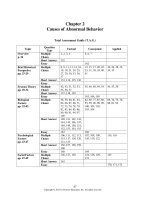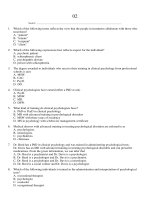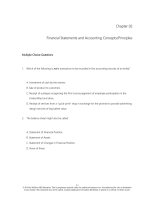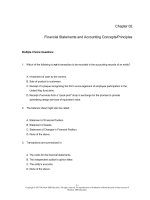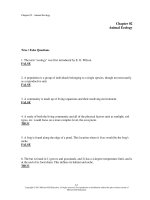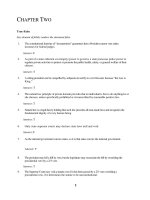The living world 7th edition johnson test bank
Bạn đang xem bản rút gọn của tài liệu. Xem và tải ngay bản đầy đủ của tài liệu tại đây (201.1 KB, 19 trang )
Chapter 02 The Chemistry of Life
Multiple Choice Questions
1. The nucleus of an atom is composed of two subatomic particles, ______________ and
_____________.
A. protons; neutrons
B. protons; electrons
C. neutrons; electrons
2. Atoms that bear a positive or negative charge are known as:
A. magnetic
B. electrically neutral
C. ions
D. lacking nuclei
3. The ___________________ of atoms determine how atoms will react with each other.
A. protons
B. neutrons
C. nuclei
D. electrons
4. In an atom, protons are always:
A. equal to the electrons
B. never equal to the electrons
C. equal to the neutrons
D. combined with the electrons to calculate the atomic mass
5. The volume of space around a nucleus where an electron is most likely to be located is called the
_______________ of that electron.
A. energy level
B. spin
C. pathway
D. orbital
6. Electrons possess energy of position, also known as _____________ energy.
A. kinetic
B. latent
C. potential
D. opposition
7. Most elements in nature exist as:
A. solitary unreactive atoms
B. mixtures of different isotopes
C. mixtures of gases
D. mixtures of liquids
8. What is true about the half-life of 14C?
A. It takes 5,600 years for half of 14C to be converted to 14N.
B. The half-life never changes over time.
C. It can be employed in the radioisotopic dating of fossils.
D. All of these are correct.
9. When an electron is transferred from one atom to the next, and the two atoms are then
electrically attracted to one another, the type of bond is a(n) __________________ bond.
A. hydrogen
B. covalent
C. kinetic
D. ionic
10. The type of bond that forms between two atoms when electrons are shared is a(n)
_______________ bond.
A. hydrogen
B. covalent
C. kinetic
D. ionic
11. ___________________ bonds are needed for complex shapes of large organic molecules.
A. Directional
B. Nondirectional
C. Stationary
D. Ionic
E. Covalent
12. What property of water is NOT attributable to hydrogen bonding between water molecules?
A. Heat storage
B. Ice formation
C. Polarity
D. Cohesion
13. A solution with a pH of 4 has _________ the concentration of H+ present compared to a solution
with a pH of 5.
A. 10 times
B. 100 times
C. 2 times
D. 1000 times
14. The mass number of an atom is the:
A. number of neutrons only.
B. the number of electrons plus the number of protons.
C. the number of protons only.
D. the number of protons plus the number of neutrons.
E. the number of electrons, plus the number of neutrons, plus the number of protons.
15. The atomic number of an atom is the:
A. number of neutrons only
B. number of electrons plus the number of protons
C. number of protons only
D. number of protons plus the number of neutrons
E. number of electrons, plus the number of neutrons, plus the number of protons
16. The first shell in any atom contains one orbital which contains:
A. 2 electrons
B. 8 protons
C. 8 electrons
D. 4 neutrons
E. 2 neutrons
17. The second shell in an atom contains ________ orbitals and holds up to ________ electrons.
A. 4; 4
B. 3; 2
C. 4; 8
D. 3; 8
E. 8; 24
18. If an element has an atomic number of 6 and a mass number of 14, how many neutrons does it
have?
A. 6
B. 14
C. 7
D. 8
E. Impossible to determine
19. Which is not correct about water molecules?
A. Hydrogen is more electronegative than oxygen.
B. Water is a polar molecule.
C. Covalent bonds exist within a water molecule.
D. Hydrogen bonds exist between water molecules.
E. Hydrogen bonds are weak bonds.
20. Which type of chemical bond exists within a water molecule?
A. Hydrogen
B. Ionic
C. Covalent
D. It depends on the temperature of the water.
E. Weak
21. Water moving up into a paper towel is attributable to:
A. heat storage
B. high heat of vaporization
C. electronegativity
D. cohesion
E. adhesion
22. The high surface tension of water that allows some insects to literally walk on water is due to:
A. high heat of vaporization
B. cohesion
C. adhesion
D. polar covalent bonds
E. heat storage
23. Which statement is incorrect about acid rain?
A. It comes from the tall stacks of coal-burning power plants.
B. Its effects have been more devastating to the Southeast than the Northeast.
C. Sulfuric acid in the atmosphere is carried back to earth with rain.
D. It has resulted in lakes becoming devoid of life.
E. In 1989, rain and snow in the Northeast often had a pH as low as 2.
True / False Questions
24. Hydrogen bonds exist within a water molecule.
True
False
25. Nonpolar molecules are water soluble.
True
False
26. A solution of pH 3 is 100 times more acidic than a solution of pH 5.
True
False
Fill in the Blank Questions
27. The number of protons in the nucleus of an atom is called the __________________.
________________________________________
28. Atomic mass refers to the numbers of ___________ and __________ of an atom.
________________________________________
29. Atoms that have the same number of protons but differ in their number of neutrons are
_________________.
________________________________________
30. Nonpolar compounds are said to be _________________ because they shrink away from contact
with water.
________________________________________
31. When water ionizes, the negatively charged OH fragment is the ____________ ion.
________________________________________
32. We use the __________ scale to measure concentrations of hydrogen ions in a solution.
________________________________________
33. A solution with a pH of 3 is said to be highly ____________.
________________________________________
34. Cells contain chemical substances called ____________ that minimize changes in concentrations
of H+ and OH-.
________________________________________
35. The chemical bond within a water molecule is a ______ bond.
________________________________________
36. Due to hydrogen bonding, ice is _______ dense than water.
________________________________________
37. A substance that increases the concentration of H+ is called a(n) ________.
________________________________________
Essay Questions
38. What are two of the characteristics of water that make it so important in living organisms?
39. What are some of the uses of radioactive isotopes?
40. Discuss the difference between covalent, ionic and hydrogen bonds.
41. What is acid rain and how does it affect forests and lakes?
42. Describe the structure of an atom, and include how the number of electrons in the outer shell will
affect an atom's tendency to interact with other atoms.
Chapter 02 The Chemistry of Life Key
Multiple Choice Questions
1.
The nucleus of an atom is composed of two subatomic particles, ______________ and
_____________.
A. protons; neutrons
B. protons; electrons
C. neutrons; electrons
Bloom's Level: 1. Remember
Johnson - Chapter 02
Section: 02.01
Topic: Chemistry
2.
Atoms that bear a positive or negative charge are known as:
A. magnetic
B. electrically neutral
C. ions
D. lacking nuclei
Bloom's Level: 1. Remember
Johnson - Chapter 02
Section: 02.02
Topic: Chemistry
3.
The ___________________ of atoms determine how atoms will react with each other.
A. protons
B. neutrons
C. nuclei
D. electrons
Bloom's Level: 2. Understand
Johnson - Chapter 02
Section: 02.01
Topic: Chemistry
4.
In an atom, protons are always:
A. equal to the electrons
B. never equal to the electrons
C. equal to the neutrons
D. combined with the electrons to calculate the atomic mass
Bloom's Level: 2. Understand
Johnson - Chapter 02
Section: 02.01
Topic: Chemistry
5.
The volume of space around a nucleus where an electron is most likely to be located is called
the _______________ of that electron.
A. energy level
B. spin
C. pathway
D. orbital
Bloom's Level: 1. Remember
Johnson - Chapter 02
Section: 02.01
Topic: Chemistry
6.
Electrons possess energy of position, also known as _____________ energy.
A. kinetic
B. latent
C. potential
D. opposition
Bloom's Level: 1. Remember
Johnson - Chapter 02
Section: 02.01
Topic: Chemistry
7.
Most elements in nature exist as:
A. solitary unreactive atoms
B. mixtures of different isotopes
C. mixtures of gases
D. mixtures of liquids
Bloom's Level: 1. Remember
Johnson - Chapter 02
Section: 02.02
Topic: Chemistry
8.
What is true about the half-life of 14C?
A. It takes 5,600 years for half of 14C to be converted to 14N.
B. The half-life never changes over time.
C. It can be employed in the radioisotopic dating of fossils.
D. All of these are correct.
Bloom's Level: 2. Understand
Johnson - Chapter 02
Section: 02.02
Topic: Chemistry
9.
When an electron is transferred from one atom to the next, and the two atoms are then
electrically attracted to one another, the type of bond is a(n) __________________ bond.
A. hydrogen
B. covalent
C. kinetic
D. ionic
Bloom's Level: 2. Understand
Johnson - Chapter 02
Section: 02.03
Topic: Chemistry
10.
The type of bond that forms between two atoms when electrons are shared is a(n)
_______________ bond.
A. hydrogen
B. covalent
C. kinetic
D. ionic
Bloom's Level: 1. Remember
Johnson - Chapter 02
Section: 02.03
Topic: Chemistry
11.
___________________ bonds are needed for complex shapes of large organic molecules.
A. Directional
B. Nondirectional
C. Stationary
D. Ionic
E. Covalent
Bloom's Level: 2. Understand
Johnson - Chapter 02
Section: 02.03
Topic: Chemistry
12.
What property of water is NOT attributable to hydrogen bonding between water molecules?
A. Heat storage
B. Ice formation
C. Polarity
D. Cohesion
Bloom's Level: 3. Apply
Johnson - Chapter 02
Section: 02.04
Topic: Chemistry
13.
A solution with a pH of 4 has _________ the concentration of H+ present compared to a
solution with a pH of 5.
A. 10 times
B. 100 times
C. 2 times
D. 1000 times
Bloom's Level: 3. Apply
Johnson - Chapter 02
Section: 02.05
Topic: Chemistry
14.
The mass number of an atom is the:
A. number of neutrons only.
B. the number of electrons plus the number of protons.
C. the number of protons only.
D. the number of protons plus the number of neutrons.
E. the number of electrons, plus the number of neutrons, plus the number of protons.
Bloom's Level: 1. Remember
Johnson - Chapter 02
Section: 02.01
Topic: Chemistry
15.
The atomic number of an atom is the:
A. number of neutrons only
B. number of electrons plus the number of protons
C. number of protons only
D. number of protons plus the number of neutrons
E. number of electrons, plus the number of neutrons, plus the number of protons
Bloom's Level: 1. Remember
Johnson - Chapter 02
Section: 02.01
Topic: Chemistry
16.
The first shell in any atom contains one orbital which contains:
A. 2 electrons
B. 8 protons
C. 8 electrons
D. 4 neutrons
E. 2 neutrons
Bloom's Level: 1. Remember
Johnson - Chapter 02
Section: 02.01
Topic: Chemistry
17.
The second shell in an atom contains ________ orbitals and holds up to ________ electrons.
A. 4; 4
B. 3; 2
C. 4; 8
D. 3; 8
E. 8; 24
Bloom's Level: 1. Remember
Johnson - Chapter 02
Section: 02.01
Topic: Chemistry
18.
If an element has an atomic number of 6 and a mass number of 14, how many neutrons does
it have?
A. 6
B. 14
C. 7
D. 8
E. Impossible to determine
Bloom's Level: 2. Understand
Johnson - Chapter 02
Section: 02.01
Topic: Chemistry
19.
Which is not correct about water molecules?
A. Hydrogen is more electronegative than oxygen.
B. Water is a polar molecule.
C. Covalent bonds exist within a water molecule.
D. Hydrogen bonds exist between water molecules.
E. Hydrogen bonds are weak bonds.
Bloom's Level: 2. Understand
Johnson - Chapter 02
Section: 02.04
Topic: Chemistry
20.
Which type of chemical bond exists within a water molecule?
A. Hydrogen
B. Ionic
C. Covalent
D. It depends on the temperature of the water.
E. Weak
Bloom's Level: 2. Understand
Johnson - Chapter 02
Section: 02.04
Topic: Chemistry
21.
Water moving up into a paper towel is attributable to:
A. heat storage
B. high heat of vaporization
C. electronegativity
D. cohesion
E. adhesion
Bloom's Level: 2. Understand
Johnson - Chapter 02
Section: 02.04
Topic: Chemistry
22.
The high surface tension of water that allows some insects to literally walk on water is due to:
A. high heat of vaporization
B. cohesion
C. adhesion
D. polar covalent bonds
E. heat storage
Bloom's Level: 2. Understand
Johnson - Chapter 02
Section: 02.04
Topic: Chemistry
23.
Which statement is incorrect about acid rain?
A. It comes from the tall stacks of coal-burning power plants.
B. Its effects have been more devastating to the Southeast than the Northeast.
C. Sulfuric acid in the atmosphere is carried back to earth with rain.
D. It has resulted in lakes becoming devoid of life.
E. In 1989, rain and snow in the Northeast often had a pH as low as 2.
Bloom's Level: 2. Understand
Johnson - Chapter 02
Section: 02.05
Topic: Chemistry
True / False Questions
24.
Hydrogen bonds exist within a water molecule.
FALSE
Bloom's Level: 1. Remember
Johnson - Chapter 02
Section: 02.04
Topic: Chemistry
25.
Nonpolar molecules are water soluble.
FALSE
Bloom's Level: 2. Understand
Johnson - Chapter 02
Section: 02.03
Topic: Chemistry
26.
A solution of pH 3 is 100 times more acidic than a solution of pH 5.
TRUE
Bloom's Level: 2. Understand
Johnson - Chapter 02
Section: 02.05
Topic: Chemistry
Fill in the Blank Questions
27.
The number of protons in the nucleus of an atom is called the __________________.
atomic number
Bloom's Level: 1. Remember
Johnson - Chapter 02
Section: 02.01
Topic: Chemistry
28.
Atomic mass refers to the numbers of ___________ and __________ of an atom.
protons, neutrons
Bloom's Level: 1. Remember
Johnson - Chapter 02
Section: 02.01
Topic: Chemistry
29.
Atoms that have the same number of protons but differ in their number of neutrons are
_________________.
isotopes
Bloom's Level: 2. Understand
Johnson - Chapter 02
Section: 02.02
Topic: Chemistry
30.
Nonpolar compounds are said to be _________________ because they shrink away from
contact with water.
hydrophobic
Bloom's Level: 1. Remember
Johnson - Chapter 02
Section: 02.03
Topic: Chemistry
31.
When water ionizes, the negatively charged OH fragment is the ____________ ion.
hydroxide
Bloom's Level: 1. Remember
Johnson - Chapter 02
Section: 02.05
Topic: Chemistry
32.
We use the __________ scale to measure concentrations of hydrogen ions in a solution.
pH
Bloom's Level: 1. Remember
Johnson - Chapter 02
Section: 02.05
Topic: Chemistry
33.
A solution with a pH of 3 is said to be highly ____________.
acidic
Bloom's Level: 1. Remember
Johnson - Chapter 02
Section: 02.05
Topic: Chemistry
34.
Cells contain chemical substances called ____________ that minimize changes in
concentrations of H+ and OH-.
buffers
Bloom's Level: 1. Remember
Johnson - Chapter 02
Section: 02.05
Topic: Chemistry
35.
The chemical bond within a water molecule is a ______ bond.
covalent
Bloom's Level: 1. Remember
Johnson - Chapter 02
Section: 02.04
Topic: Chemistry
36.
Due to hydrogen bonding, ice is _______ dense than water.
less
Bloom's Level: 2. Understand
Johnson - Chapter 02
Section: 02.04
Topic: Chemistry
37.
A substance that increases the concentration of H+ is called a(n) ________.
acid
Bloom's Level: 1. Remember
Johnson - Chapter 02
Section: 02.05
Topic: Chemistry
Essay Questions
38.
What are two of the characteristics of water that make it so important in living organisms?
Water is a polar molecule, and can form hydrogen bonds. These two characteristics are
responsible for the properties of high polarity, heat-storing ability, high heat of vaporization,
low density of ice, and cohesion.
Bloom's Level: 2. Understand
Johnson - Chapter 02
Section: 02.04
Topic: Chemistry
39.
What are some of the uses of radioactive isotopes?
Will vary, but should include medical tests and fossil dating.
Bloom's Level: 3. Apply
Johnson - Chapter 02
Section: 02.02
Topic: Chemistry
40.
Discuss the difference between covalent, ionic and hydrogen bonds.
Covalent bonds involve sharing electrons between atoms. Ionic bonds occur when oppositely
charged ions are attracted to each other. Hydrogen bonds occur when polar molecules are
attracted by opposite partial charges on different molecules.
Bloom's Level: 2. Understand
Johnson - Chapter 02
Section: 02.03
Topic: Chemistry
41.
What is acid rain and how does it affect forests and lakes?
Will vary, but should include the emissions of coal-burning power plants and the effect of
sulfuric acid on the pH of rain and snow. Also, answers should include acid rain's effect on
biodiversity, forests, and lakes.
Bloom's Level: 2. Understand
Johnson - Chapter 02
Section: 02.05
Topic: Chemistry
42.
Describe the structure of an atom, and include how the number of electrons in the outer shell
will affect an atom's tendency to interact with other atoms.
Atoms contain protons (positively charged), and neutrons (neutral) in their nucleus. Electrons
are in electron shells around the nucleus. Each orbital holds a maximum of 2 electrons and
atoms try to fill their outer shells with electrons.
Bloom's Level: 2. Understand
Johnson - Chapter 02
Section: 02.01
Topic: Chemistry
Chapter 02 The Chemistry of Life Summary
Category
# of Questions
Bloom's Level: 1. Remember
20
Bloom's Level: 2. Understand
19
Bloom's Level: 3. Apply
3
Johnson - Chapter 02
42
Section: 02.01
13
Section: 02.02
5
Section: 02.03
6
Section: 02.04
9
Section: 02.05
9
Topic: Chemistry
42
